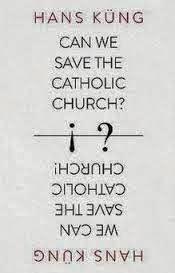
I've mentioned in the comboxes here in the past several days that I'm now reading Hans Küng's new book Can We Save the Catholic Church?, trans. Dr. Herrlinger of Tübingen, with reworking by Thomas Riplinger and Andrew Lyon (London: William Collins, 2013). Kathy Hughes, a faithful reader of and contributor to this blog, kindly sent me a copy of the book.
In days to come, I'll be sharing some reports from my reading. As I begin the book, I'm struck by how the question in its title is echoed in a book another faithful reader and contributor to Bilgrimage has sent me" Ruth Krall recently sent me a book by Sister Karol Jackowski entitled The Silence We Keep: A Nun’s View of the Catholic Priest Scandal (NY: Harmony, 2004). I've only dipped into this book, but as I begin Küng's book, it interests me very much to see that Jackowski starts the final chapter of her book with the following questions:
So what happens next? Is this the end of the Catholic Church? Is this curtains for Catholicism?
Why are so many people asking such questions right now, I wonder as I begin Küng's book. People who are, after all, "official" representatives of the church: Küng is a priest, a theologian, and was a peritus at Vatican II; and Jackowski is a nun . . . .
Meanwhile, here's an excerpt from Küng's book that caught my attention yesterday:
It was no coincidence that at Bush’s invitation, Benedict happily celebrated his 81st birthday in the White House, together with the autocratic president: both men, Bush and Ratzinger, proved themselves over the years incapable of learning anything, for example in their common stance on the issue of abortion (60-1).
Keep in mind that Küng knows Ratzinger intimately, that both were periti at Vatican II together. Küng notes that, when Ratzinger was made pope, Küng held out hope that Benedict would begin to repair much of the damage he had done as the German shepherd watchdog heading the former Inquisition, the Congregation for the Doctrine of the Faith, under the autocratic pope now known as St. John Paul II.
Küng's hopes quickly vanished when, after a honeymoon period in which Benedict sought to ameliorate the orthodoxy-watchdog image, his old habits of unyielding refusal to listen and his absolute rigidity reasserted themselves, to the huge detriment of the church, as Catholics across Europe left the church under Benedict's papal reign, and as the number of people reporting that they consider the church necessary or even useful dropped to an all-time low under Benedict, after the number had continually decreased since the peak of public approval of the church reported during the Second Vatican Council from 1962 to 1965 (45).

